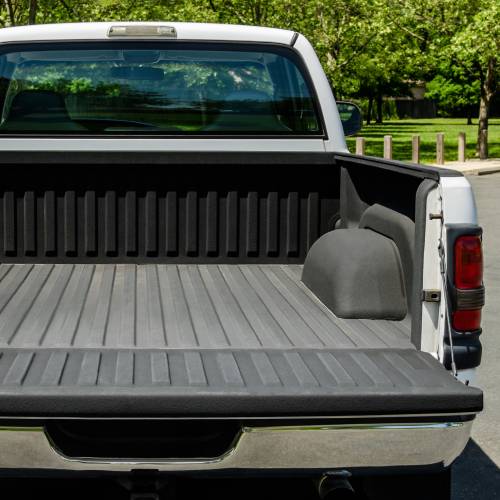From all that furniture on moving day to the haul of project supplies, your truck bed takes on a lot. That’s why it’s such a smart idea to protect it with lining. A quality liner can help you avoid scratches, corrosion, and other damage from impacting the bed of your truck.
While its job is to safeguard against damage, your truck bed liner requires maintenance to stay in peak shape, just like any other part of your truck. Neglecting it can lead to premature wear and tear, rendering it less effective over time. Keeping that in mind, follow along for five ways to maintain your truck bed lining to keep it looking good for longer.
1. Keep a Cover Over the Bed
Acting like a removable roof, covers can protect both your cargo and the truck bed lining from anything Mother Nature might throw your way. For instance, the cover blocks rain so you won’t have to worry about standing water or moisture causing rust or corrosion. UV rays are also kept at bay to prevent fading and sun damage. Also, instead of seeing scratches or dents from the leaves, branches, and whatever else the wind blows in, your truck bed will stay in top shape.
2. Regularly Clean Your Liner

A cover can’t stop everything. Every time you open your truck bed to store and remove items, there’s a chance something gets left behind. Even just sitting unused, dirt, dust, and debris can sneak their way in.
These particles can scratch the liner’s surface and cause wear, weakening the liner so it’s less effective at protecting your truck bed. Clean your truck bed lining regularly to prevent this, removing loose debris, such as leaves, sand, or stray cargo. You can use a broom or a vacuum for this step.
Next, wash the bed liner with mild soap and warm water. Avoid using harsh chemicals or abrasive materials when cleaning your liner, as they can damage the protective coating. If you must use a pressure washer, operate it on a moderate setting to avoid damaging the liner. After rinsing, dry the liner thoroughly to prevent moisture from seeping into cracks or crevices.
For tougher contaminants, such as spilled oil or chemicals, you may need a cleaner made specifically for bed liners. With this product in hand, you can tackle stubborn stains without causing damage to the liner material.
3. Watch What You’re Loading
Your truck bed is meant for hauling, but it’s essential to be mindful of what you’re loading into it. For instance, dragging heavy materials like furniture, appliances, or construction supplies across the bed liner can cause deep scratches and gouges.
Prevent damage by carefully lifting and placing your cargo into the bed. Using a ramp can make this process much easier, especially for heavier or bulkier items. A sturdy ramp provides a smooth, controlled way to load your cargo without risking damage to your truck or straining yourself.

Once your cargo is safely in the truck bed, take the time to secure it. Loose items risk falling off on the road or getting damaged. Plus, they can affect your truck bed liner by sliding around and causing scratches or dents.
Arrange items tightly to fill gaps and prevent shifting while you’re on the road. Avoid leaving any item in a precarious position where it could tip or slide. Heavy items should go on the bottom, with lighter ones stacked securely on top.
Keep everything locked in place with strong straps or bungee cords. Anchor the cords to the tie-down points in your truck bed so nothing moves, even during sharp turns or sudden stops.
Here’s another tip: when carrying particularly heavy or sharp-edged items, it’s worth adding an extra layer of protection to your truck bed liner. A tarp or rubber bed mat can act as a buffer, absorbing impacts and reducing direct contact with the liner.
4. Keep an Eye Out for Damage
Even with preventative measures in place, plan for regular inspections of your truck bed liner. Spotting damage early can help you address it before it worsens. Look for common signs of liner damage, including cracks, dents, peeling, or areas where the liner material appears thinner. For drop-in liners, check for spots where the liner may have come loose, as this can lead to friction damage or expose the truck bed to the elements.
If you notice issues, plan for immediate repairs. You can typically fix small cracks or scratches with a bed liner repair kit. For more significant damage, you may need to consult a professional for a thorough repair or consider replacing the liner.
5. Replace Truck Bed Lining
Over time, even the most well-maintained bed liner will wear down, especially if you use your truck frequently or for heavy-duty work. Reapplying or refreshing the liner is a great way to provide long-term protection for your vehicle.
When it’s time for a new coat, thoroughly clean the truck bed surface first. Remove dirt or debris that could affect adhesion, then follow the manufacturer’s instructions for applying the coating.
Reapplying or replacing your truck bed liner enhances its durability and gives your truck bed a fresh, clean appearance. It’s a worthwhile upgrade that pays off aesthetically and functionally.
Keep Your Truck in Top Shape With the Right Supplies
With these five ways to maintain your truck bed lining, you can extend its life and keep your truck looking great for years to come. Regular maintenance protects your investment so your truck is always ready for the toughest jobs.
Do you need supplies to keep your truck in top shape? Eagle National Supply has truck bed coatings and more. Shop with us today to find the gear that keeps your truck ready for anything!


